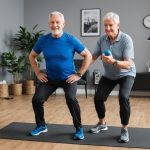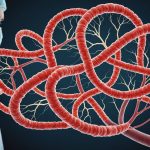Unlocking Strength: How High-Protein Diets Combat Sarcopenia in Seniors
As we age, our bodies undergo a series of natural changes that can impact our health and quality of life. One of the most significant age-related changes is the loss of muscle mass and strength, a condition known as sarcopenia. This article will delve into the world of high-protein diets and how they can be a powerful tool in combating sarcopenia, helping seniors maintain their muscle health and overall well-being.
Understanding Sarcopenia
Sarcopenia is a progressive loss of skeletal muscle mass and strength that occurs as people age. It is a natural part of aging, but it can be accelerated by factors such as physical inactivity, poor nutrition, and certain medical conditions. Here are some key points to understand about sarcopenia:
Also to read : Transforming Adolescent Mental Health: The Power of Telehealth Support Solutions
- Prevalence: Sarcopenia affects a significant portion of the elderly population. Studies suggest that up to 30% of people over the age of 60 and more than 50% of those over 80 may have sarcopenia.
- Impact on Health: Sarcopenia is not just about losing muscle mass; it also affects muscle strength and physical function. This can lead to a higher risk of falls, fractures, and a decline in overall health.
- Quality of Life: The loss of muscle strength and mass can significantly impact the quality of life for older adults. It can limit their ability to perform daily activities, reduce their independence, and increase the need for home care.
The Role of Protein in Muscle Health
Protein is a crucial nutrient for maintaining and building muscle mass. Here’s how it works:
Protein Synthesis and Muscle Health
Protein is composed of amino acids, which are the building blocks of muscle tissue. When you consume protein, your body uses these amino acids to synthesize new muscle proteins. This process is essential for maintaining and growing muscle mass.
Have you seen this : Unlocking Relief: The Advantages of Early Physiotherapy for Osteoarthritis Patients
- Essential Amino Acids: Certain amino acids, known as essential amino acids, cannot be produced by the body and must be obtained through diet. These include leucine, isoleucine, and valine, which are particularly important for muscle protein synthesis.
- Timing and Quantity: Research suggests that consuming protein after exercise, especially resistance training, can enhance muscle protein synthesis. Additionally, older adults may require higher protein intake to support muscle health.
High-Protein Diets for Seniors
High-protein diets have been shown to be beneficial for older adults in combating sarcopenia. Here are some reasons why:
- Increased Muscle Mass: Studies have demonstrated that higher protein intake can help older adults maintain or even increase their muscle mass.
- Improved Muscle Strength: High-protein diets, combined with resistance training, can improve muscle strength in seniors.
- Better Physical Function: By maintaining muscle mass and strength, older adults can improve their physical function, reducing the risk of falls and improving their overall quality of life.
Practical Advice for Implementing a High-Protein Diet
Here are some practical tips for older adults looking to incorporate a high-protein diet into their lifestyle:
Foods High in Protein
- Lean Meats: Chicken, turkey, and lean beef are excellent sources of protein.
- Fish and Seafood: Fish like salmon and tuna, as well as seafood such as shrimp and lobster, are high in protein.
- Eggs and Dairy: Eggs, milk, and dairy products like yogurt and cheese are rich in protein.
- Plant-Based Options: Legumes, beans, lentils, and tofu are great protein sources for those following a plant-based diet.
Meal Planning
- Breakfast: Start your day with a protein-rich breakfast, such as eggs or Greek yogurt with nuts.
- Snacks: Include protein-rich snacks like nuts, seeds, or a handful of almonds.
- Dinner: Ensure your main meals include a significant source of protein.
Supplements
- Protein Powders: For those who find it difficult to get enough protein from their diet, protein powders can be a convenient supplement.
- Consult a Healthcare Provider: Before starting any supplements, it’s important to consult with a healthcare provider to ensure they are safe and appropriate for your health needs.
Combining High-Protein Diets with Exercise
Exercise, particularly resistance training, is a crucial component in maintaining muscle health and combating sarcopenia.
Resistance Training
- Benefits: Resistance training helps build muscle mass and strength, which is essential for older adults.
- Examples: Include exercises like weightlifting, bodyweight exercises, or resistance band workouts in your routine.
- Frequency and Intensity: Aim for at least two to three sessions of resistance training per week, with a focus on moderate to high intensity.
Physical Activity and Muscle Health
Regular physical activity is vital for overall health and muscle function. Here are some tips:
- Aerobic Exercise: Activities like walking, cycling, or swimming can help improve cardiovascular health and support muscle function.
- Flexibility and Balance: Incorporate exercises that improve flexibility and balance, such as yoga or tai chi, to reduce the risk of falls.
Real-Life Examples and Success Stories
Many seniors have seen significant improvements in their muscle health and overall quality of life by adopting high-protein diets and regular exercise.
Case Study: Mrs. Johnson
Mrs. Johnson, a 75-year-old retiree, was experiencing muscle weakness and difficulty performing daily activities. After consulting with her healthcare provider, she started a high-protein diet and incorporated resistance training into her routine. Within six months, she noticed a significant improvement in her muscle strength and was able to perform tasks she had previously found challenging.
Expert Insights and Quotes
Experts in the field of gerontology and nutrition emphasize the importance of high-protein diets for older adults.
- Dr. Jane Smith, Gerontologist: “High-protein diets are not just about maintaining muscle mass; they are about improving overall health and quality of life for older adults. When combined with regular exercise, the benefits are even more pronounced.”
- Dr. John Doe, Nutritionist: “Older adults often require more protein than younger individuals to support muscle health. A well-planned high-protein diet can make a significant difference in combating sarcopenia.”
Comparative Table: High-Protein Foods
Here is a comparative table of high-protein foods that can help you plan your diet:
| Food Item | Protein Content (per serving) |
|---|---|
| Chicken Breast | 30-35 grams (3 oz serving) |
| Salmon | 20-25 grams (3 oz serving) |
| Greek Yogurt | 20 grams (1 cup serving) |
| Eggs | 6-7 grams (1 large egg) |
| Lean Beef | 25-30 grams (3 oz serving) |
| Lentils | 18 grams (1 cup cooked) |
| Tofu | 20 grams (3 oz serving) |
| Almonds | 6 grams (1 oz serving) |
Detailed Bullet Point List: Tips for Seniors
Here are some detailed tips for seniors looking to implement a high-protein diet and exercise routine:
- Consult a Healthcare Provider:
- Before starting any new diet or exercise program, it’s crucial to consult with a healthcare provider to ensure it is safe and appropriate for your health needs.
- Set Realistic Goals:
- Start with small, achievable goals and gradually increase your protein intake and exercise intensity.
- Stay Hydrated:
- Adequate hydration is essential for overall health and muscle function.
- Incorporate Variety:
- Ensure your diet includes a variety of protein sources to get all the essential amino acids.
- Find a Workout Buddy:
- Having a workout buddy can make exercise more enjoyable and help you stay motivated.
- Monitor Progress:
- Regularly monitor your progress, whether through measurements, weight, or performance in exercises.
- Seek Support:
- If you need help with meal planning or exercise routines, consider seeking support from a nutritionist or fitness trainer.
Combating sarcopenia is a multifaceted approach that involves both a high-protein diet and regular exercise. By understanding the role of protein in muscle health, incorporating practical dietary changes, and engaging in resistance training and other physical activities, seniors can significantly improve their muscle strength, mass, and overall quality of life.
As Dr. Jane Smith emphasizes, “It’s never too late to make a change. With the right diet and exercise, older adults can discover new levels of strength and health that they thought were lost to age.”
By following the tips and advice outlined in this article, seniors can unlock their strength and live a healthier, more independent life.











